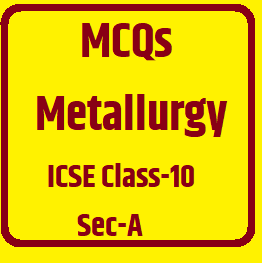MCQ Metallurgy Class-10 for ICSE Chemistry Sec-A Sem-2 . These MCQ / Objective Type Questions is based on latest reduced syllabus according 2021-22 session on bifurcated pattern. Main motto of MCQ Type Question is cracking the next upcoming Sem-2 exam of council. Visit official website CISCE for detail information about ICSE Board Class-10 Chemistry .
MCQ Metallurgy Class-10 for ICSE Class-10 Sec-A Sem-2
| Board | ICSE |
| Class | 10th (X) |
| Subject | Chemistry |
| Chapter | Metallurgy |
| Syllabus | on bifurcated syllabus (after reduction) |
| Session | 2021-22 |
| Bifurcated | Sem-2 |
| Topic | MCQ / Objective Type Question for Sec-A |
Sec-A Sem-2 ICSE Class-10 Chemistry MCQ Type Questions of Metallurgy

Question 1: The most abundant metal in the earth’s crust is
(a) Iron
(b) Aluminum
(c) Calcium
(d) Sodium
Answer (b) Aluminium
Question 2: Which property of metals is used for making bells and strings of musical instruments like Sitar and Violin?
(a) Sonorousness
(b) Malleability
(c) Ductility
(d) Conductivity
Answer (a) Sonorousness
Question 3: Which among the given alloys contain non-metal as one of its constituents?
(a) Brass
(b) Amalgam
(c) Gunmetal
(d) None of these
Answer (b) Amalgam
Question 4: An aluminum strip is kept immersed in freshly prepared ferrous sulphate solution taken in a test tube, the change observed is that
(a) Green solution slowly turns brown
(b) Lower end of test tube become slightly warm
(c) A colorless gas with the smell of burning Sulphur is observed
(d) Light green solution changes to blue
Answer (a) Green solution slowly turns brown
Question 5: Which of the given metals cannot be extracted using smelting?
(a) Fe
(b) Al
(c) Zn
(d) Pb
Answer (b) Al
Question 6: In general, the number of electrons in the outermost shell of a metal atom is
(a) 1
(b) 1 to 3
(c) 5 to 8
(d) 8
Answer (b) 1 to 3
Question 7: Aluminum is used for making cooking utensils. Which of the following properties of aluminum are responsible for the same?
(a) Good thermal conductivity
(b) Good electrical conductivity
(c) Ductility
(d) High melting point
(a) (A) & (B)
(b) (A) & (C)
(c) (B) & (C)
(d) (A) & (D)
Answer (d) (A) & (D)
Question 8: Which of the following is the correct arrange-ment of the given metals in ascending order of their reactivity?
Zinc, Iron, Magnesium, Sodium
(a) Zinc > Iron > Magnesium > Sodium
(b) Sodium > Magnesium > Iron > Zinc
(c) Sodium > Zinc > Magnesium > Iron
(d) Sodium > Magnesium > Zinc > Iron
Answer (d) Sodium > Magnesium > Zinc > Iron
Question 9: Which of the following pairs will give dis-placement reactions?
(a) FeSO4 solution and Copper metal
(b) AgNO3 solution and Copper metal
(c) CuSO4 solution and Silver metal
(d) NaCl solution and Copper metal
Answer (b) AgNO3 solution and Copper metal
Question 10: Non-metals form covalent chlorides because
(a) they can give electrons to chlorine
(b) they can share electrons with chlorine
(c) they can give electrons to chlorine atoms to form chloride ions
(d) they cannot share electrons with chlorine atoms
Answer (b) they can share electrons with chlorine
Question 11: Aluminium is used for making cooking utensils. Which of the following properties of alu¬minium are responsible for the same?
(i) Good thermal conductivity
(ii) Good electrical conductivity
(iii) Ductility
(iv) High melting point
(a) (i) and (ii)
(b) (i) and (iii)
(c) (ii) and (iii)
(d) (i) and (iv)
Answer (d) (i) and (iv)
Question 12: Which of the following oxide(s) of iron would be obtained on prolonged reaction of iron with steam?
(a) FeO
(b) Fe2O3
(c) Fe3O4
(d) Fe2O3 and Fe2O4
Answer (c) Fe3O4
Question 13: Which of tire following are not ionic compounds?
(i) KCl
(ii) HCl
(iii) CCl4
(iv) NaCl
(a) (i) and (ii)
(b) (ii) and (iii)
(c) (iii) and (iv)
(d) (i) and (iii)
Answer (b) (ii) and (iii)
Question 14: An alloy reacted with dilute hydrochloric acid to produce a gas which ‘pops’ a lighted splint. The residue reacted with dilute nitric acid to form a blue solution. Which one of the following pairs of metals is present in the alloy?
(a) Copper and lead
(b) Lead and magnesium
(c) Copper and magnesium
(d) Lead and zinc
Answer (c) Copper and magnesium
Question 15: Which of the following metals exist in their native state in nature?
(i) Cu
(ii) Au
(iii) Zn
(iv) Ag
(a) (i) and (ii)
(b) (ii) and (iii)
(c) (ii) and (iv)
(d) (iii) and (iv)
Answer (c) (ii) and (iv)
Question 16: Metals are refined by using different methods. Which of the following metals are refined by electrolytic refining?
(i) Au
(ii) Cu
(iii) Na
(iv) K
(a) (i) and (ii)
(b) (i) and (iii)
(c) (ii) and (iii)
(d) (iii)and (iv)
Answer (a) (i) and (ii)
Question 17: Metal M occurs in the Earth’s crust as its oxide M2O3. An alloy of this metal is used in making aircrafts. The ore of the metal M is
(a) magnetite
(b) haematite
(c) bauxite
(d) pyrolusite
Answer (c) bauxite
Question 18: Which of the given can undergo a chemical reaction?
(a) MgSO₄ + Fe
(b) ZnSO₄ + Fe
(c) MgSO₄ + Pb
(d) CuSO₄ + Fe
Answer D. CuSO₄ + Fe
Question 19: Which of the given metals is present in the anode mud during the electrolytic refining of copper?
(a) Sodium
(b) Aluminium
(c) Gold
(d) Iron
Answer (d) Iron
Question 20: An element reacts with oxygen to give a compound with a high melting point. The compound is soluble in water. The element is likely to be
(a) Calcium
(b) Carbon
(c) Iron
(d) Silicon
Answer (c) Iron
Question 21: The second most abundant metal in the earth’s crust is
(a) Oxygen
(b) Silicon
(c) Aluminum
(d) Iron
Answer (d) Iron
Question 22: An alloy of Zn and Cu is dissolved in dil. HCl. Hydrogen gas is evolved. In this evolution of gas
(a) Only zinc reacts with dil. HCl
(b) Only copper reacts with dil. HCl
(c) Both zinc and copper react with dil. HCl
(d) Only copper reacts with water
Answer (a) Only zinc reacts with dil. HCl
Question 23: A greenish coating develops on copper utensils due to formation of
(a) CuCO₃
(b) Cu(OH)₂
(c) Cu(OH)₂.CuCO₃
(d) CuO
Answer (a) CuCO₃
Question 24: Rusting of iron takes place in
(a) Ordinary water
(b) Distilled water
(c) Both ordinary & Distilled water
(d) None of these
Answer (c) Both ordinary & Distilled water
Question 25: The bronze medals are made up of
(a) Cu and Zn
(b) Zn and Ni
(c) Cu and Sn
(d) Cu, Zn, Tn
Answer (c) Cu and Sn
Question 26: Silver articles become black on prolonged exposure to air. This is due to the formation of
(a) Ag₂O
(b) Ag₂S
(c) AgCN
(d) Ag₂O and Ag₂S
Answer (b) Ag₂S
Question 27: During smelting, an additional substance is added which combines with impurities to form a fusible product known as
(a) Slag
(b) Mud
(c) Gangue
(d) Flux
Answer (a) Slag
Question 28: A student placed an iron nail in copper sulphate solution. He observed the reddish brown coating on the iron nail which is
(a) Soft and dull
(b) Hard and flading
(c) Smooth and shining
(d) Rough and granular
Answer (d) Rough and granular



